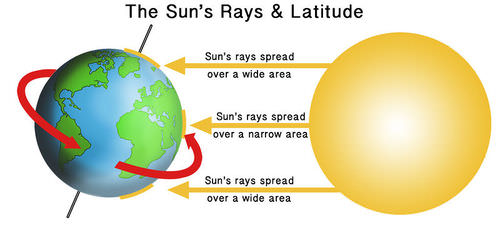10.13太阳能和纬度
章节大纲
-
Lesson
::经验教训This is Antarctica. What season is this?
::这里是南极洲 现在是哪个季节?The is always up, even in the middle of the night. That's the photo on the left. In the day , the Sun never gets too high in the sky. That's the photo on the right. So, this is summer. In the winter, it's just dark in Antarctica.
::永远是亮着的, 即使是在半夜。 这是左边的照片。 白天, 太阳在天空中不会太高。 这是右边的照片。 所以, 这是夏天。 在冬天, 南极洲的黑暗。Energy and Latitude
::能源和纬度Different parts of Earth’s surface receive different amounts of sunlight ( Figure ). The Sun’s rays strike Earth’s surface most directly at the equator . This focuses the rays on a small area. Near the poles, the Sun’s rays strike the surface at a slant. This spreads the rays over a wide area. The more focused the rays are, the more energy an area receives, and the warmer it is.
::地球表面的不同部分得到不同的阳光(图 ) 。 太阳的射线最直接地打击赤道的地球表面。 这把射线集中在一个小地区。 在极附近,太阳的射线射向倾斜面。这把射线散布在广大地区。 射线越集中,一个区域的能量就越多,温度就越高。The lowest latitudes get the most energy from the Sun. The highest latitudes get the least.
::最低纬度的能量来自太阳 最高纬度的能量最少The difference in received at different latitudes drives . Places that get more solar energy have more heat . Places that get less solar energy have less heat. Warm air rise, and cool air sinks. These principles mean that air moves around the planet . The heat moves around the globe in certain ways. This determines the way the atmosphere moves.
::不同纬度驱动器的接收差异。获得更多太阳能的地方的热量更高。获得较少太阳能的地方的热量较少。温暖的空气上升和冷却的空气汇。这些原则意味着空气环绕地球。热量以某些方式环绕全球。这决定了大气的移动方式。Summary
::摘要- A lot of the solar energy that reaches Earth hits the equator.
::到达地球的许多太阳能 撞击赤道
- Much less solar energy gets to the poles.
::光能到达极地的太阳能要少得多。
- The difference in the amount of solar energy drives atmospheric circulation.
::太阳能推动大气循环的数量差异。
Review
::回顾- The North Pole receives sunlight 24 hours a day in the summer. Why does it receive less solar radiation than the equator?
::北极夏季每天24小时得到阳光,为什么太阳辐射比赤道少?
- What part of Earth receives the most solar radiation in a year? Why?
::地球的哪个部分一年中 得到的太阳辐射最多?为什么?
- What makes the atmosphere move the way it does?
::是什么使大气层 移动的方式它做?
- A lot of the solar energy that reaches Earth hits the equator.

